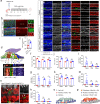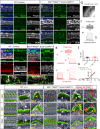Loss of Mst1/2 activity promotes non-mitotic hair cell generation in the neonatal organ of Corti
- PMID: 36280668
- PMCID: PMC9592590
- DOI: 10.1038/s41536-022-00261-4
Loss of Mst1/2 activity promotes non-mitotic hair cell generation in the neonatal organ of Corti
Abstract
Mammalian sensory hair cells (HCs) have limited capacity for regeneration, which leads to permanent hearing loss after HC death. Here, we used in vitro RNA-sequencing to show that the Hippo signaling pathway is involved in HC damage and self-repair processes. Turning off Hippo signaling through Mst1/2 inhibition or Yap overexpression induces YAP nuclear accumulation, especially in supporting cells, which induces supernumerary HC production and HC regeneration after injury. Mechanistically, these effects of Hippo signaling work synergistically with the Notch pathway. Importantly, the supernumerary HCs not only express HC markers, but also have cilia structures that are able to form neural connections to auditory regions in vivo. Taken together, regulating Hippo suggests new strategies for promoting cochlear supporting cell proliferation, HC regeneration, and reconnection with neurons in mammals.
© 2022. The Author(s).
Conflict of interest statement
The authors declare no competing interests.
Figures







Similar articles
-
The Hippo pathway and p27Kip1 cooperate to suppress mitotic regeneration in the organ of Corti and the retina.Proc Natl Acad Sci U S A. 2025 Apr 8;122(14):e2411313122. doi: 10.1073/pnas.2411313122. Epub 2025 Apr 3. Proc Natl Acad Sci U S A. 2025. PMID: 40178894
-
Hippo/YAP signaling pathway protects against neomycin-induced hair cell damage in the mouse cochlea.Cell Mol Life Sci. 2022 Jan 19;79(2):79. doi: 10.1007/s00018-021-04029-9. Cell Mol Life Sci. 2022. PMID: 35044530 Free PMC article.
-
Auditory hair cell-specific deletion of p27Kip1 in postnatal mice promotes cell-autonomous generation of new hair cells and normal hearing.J Neurosci. 2014 Nov 19;34(47):15751-63. doi: 10.1523/JNEUROSCI.3200-14.2014. J Neurosci. 2014. PMID: 25411503 Free PMC article.
-
Mammalian auditory hair cell regeneration/repair and protection: a review and future directions.Ear Nose Throat J. 1998 Apr;77(4):276, 280, 282-5. Ear Nose Throat J. 1998. PMID: 9581394 Review.
-
Hair cell regeneration from inner ear progenitors in the mammalian cochlea.Am J Stem Cells. 2020 Jun 15;9(3):25-35. eCollection 2020. Am J Stem Cells. 2020. PMID: 32699655 Free PMC article. Review.
Cited by
-
Pcolce2 overexpression promotes supporting cell reprogramming in the neonatal mouse cochlea.Cell Prolif. 2024 Aug;57(8):e13633. doi: 10.1111/cpr.13633. Epub 2024 Mar 25. Cell Prolif. 2024. PMID: 38528645 Free PMC article.
-
Conditional Overexpression of Serpine2 Promotes Hair Cell Regeneration from Lgr5+ Progenitors in the Neonatal Mouse Cochlea.Adv Sci (Weinh). 2025 May;12(18):e2412653. doi: 10.1002/advs.202412653. Epub 2025 Mar 17. Adv Sci (Weinh). 2025. PMID: 40091489 Free PMC article.
-
Exploring the potential biomarkers and potential causality of Ménière disease based on bioinformatics and machine learning.Medicine (Baltimore). 2025 May 9;104(19):e42399. doi: 10.1097/MD.0000000000042399. Medicine (Baltimore). 2025. PMID: 40355226 Free PMC article.
-
Differentially expressed miRNA profiles of serum-derived exosomes in patients with sudden sensorineural hearing loss.Front Neurol. 2023 Jun 2;14:1177988. doi: 10.3389/fneur.2023.1177988. eCollection 2023. Front Neurol. 2023. PMID: 37332997 Free PMC article.
-
The role of epigenetic modifications in sensory hair cell development, survival, and regulation.Front Cell Neurosci. 2023 Jun 14;17:1210279. doi: 10.3389/fncel.2023.1210279. eCollection 2023. Front Cell Neurosci. 2023. PMID: 37388412 Free PMC article. Review.
References
Grants and funding
- 81970879/National Natural Science Foundation of China (National Science Foundation of China)
- 81900931/National Natural Science Foundation of China (National Science Foundation of China)
- 81830029/National Natural Science Foundation of China (National Science Foundation of China)
- 82192860/National Natural Science Foundation of China (National Science Foundation of China)
- 82192861/National Natural Science Foundation of China (National Science Foundation of China)
- 2020YJZX0110/Shanghai Municipal Health Bureau (Shanghai Municipal Public Health Bureau)
- 19YF1406000/Shanghai Science and Technology Development Foundation (Shanghai Science and Technology Development Fund)
- 21ZR1411800/Shanghai Science and Technology Development Foundation (Shanghai Science and Technology Development Fund)
LinkOut - more resources
Full Text Sources
Molecular Biology Databases
Research Materials
Miscellaneous

